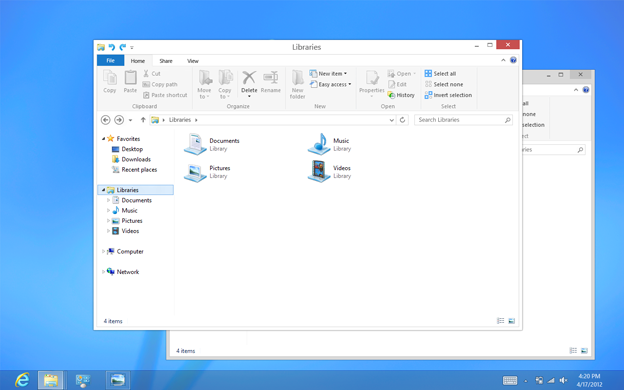One of the major interface changes that Microsoft will include in Windows 8 compared to the previous versions of its desktop platform is the lack of Aero Glass.
The company introduced this UI in Windows Vista and refined it in Windows 7 and in the first versions of Windows 8, but it will no longer pack it inside the next Windows 8 releases, it seems. Jensen Harris, director of program management for Microsoft’s User Experience team, explains in a blog post that the idea is to bring the desktop closer to the Metro aesthetic, and that they flattened surfaces, removed reflections, and scaled back distracting gradients. However, he also notes that Windows 8 would continue to use black text on light-colored chrome, as in Windows 7, so as to deliver increased compatibility with the existing platforms.
The main idea is to bring the content of the application in the center, through offering a chrome style that doesn’t distract, even if Windows 8 will move beyond Aero. Moreover, the goal was to maintain the visual compatibility with Windows 7, Harris notes. According to Microsoft, Windows 8 will arrive with a variety of improvements brought to the visual appearance of the desktop, all falling in line with the new design language that the Metro UI proposes. “We applied the principles of ‘clean and crisp’ when updating window and taskbar chrome. Gone are the glass and reflections. We squared off the edges of windows and the taskbar. We removed all the glows and gradients found on buttons within the chrome,” Harris explains.
“We made the appearance of windows crisper by removing unnecessary shadows and transparency. The default window chrome is white, creating an airy and premium look. The taskbar continues to blend into the desktop wallpaper, but appears less complicated overall.” Most of the common controls (buttons, check boxes, sliders, and the Ribbon) come with an updated appearance, with squares and edges, flattened backgrounds, and tweaked colors to feel “modern and natural.” Some of these changes will make it to Windows 8 Release Preview, which is due in a couple of weeks, while others will not be visible until the final flavor of the new platform is made available.
The upcoming iterations of the operating system will also bring a series of improvements in usability, specifically in areas such as swiping from edges and moving the mouse to the corner. Those who use a mouse will find it more easily to target corners with it in the future releases, while the touch capabilities will be better in upcoming hardware, specifically designed for Windows 8. Although many complained about the fact that Windows 8 is hard to use on traditional computers, Microsoft is confident that people will adapt, and that they will eventually find the platform great to use.
Overall, Windows 8 comes with a user experience that, in Microsoft’s vision, is a bet on the future of computing. The platform should play an important role in this, the Redmond-based software giant notes. “We tried to break new ground in imagining how using a PC might become a fluid and enjoyable experience, how apps might work together to simplify the tasks you do every day, and how a single screen could bring together everything you love and care about into one always up-to-date place,” Harris adds.
Windows 8 was designed towards the convergence of tablets and lightweight laptops, but a full image over what it has to offer won’t be available until the first hardware from Microsoft’s partners arrive on shelves. “Our vision for Windows 8 was to create a modern, fast and fluid user experience that defines the platform for the next decade of computing. One which upends the way conventional people think about tablets and laptops and the role of the devices they carry,” he concludes.



 5/22/2012 07:42:00 PM
5/22/2012 07:42:00 PM
 dannzfay
dannzfay


 Posted in:
Posted in: 









0 comments:
Post a Comment